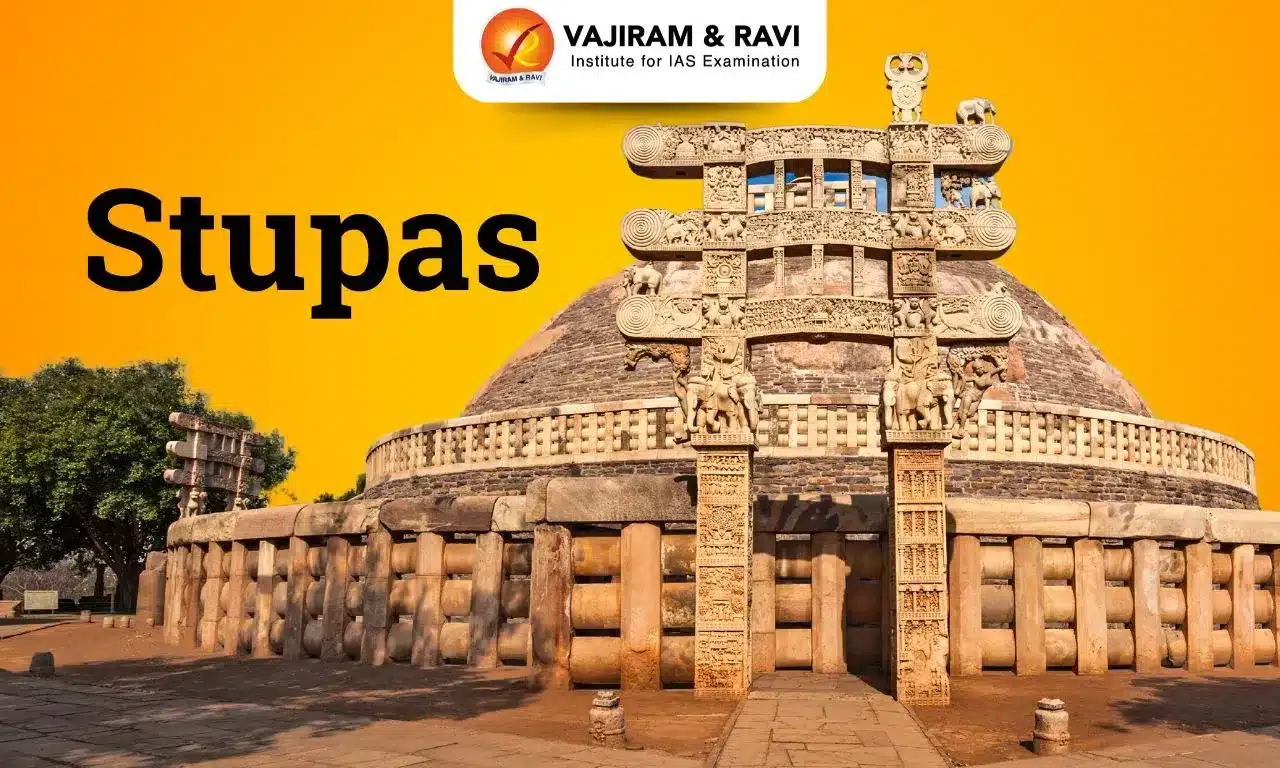A Stupa is a dome-shaped sacred monument containing relics of the Buddha or other sacred objects. It holds religious and symbolic significance in Buddhist architecture. Originating in India before the 5th century BCE, stupas evolved from simple burial mounds into sacred Buddhist monuments, becoming central to Buddhist worship and practice.
The term stupa is mentioned in Rigveda (estuka), Atharvaveda, and other texts, referring to structures raised on the ground. The Pali term “thupa” signifies a conical heap or shrine containing a relic.
Stupas Origin, Evolution
The stupa was originally a funerary mound in ancient India, but it gradually evolved into a religious monument associated with the Buddha and his teachings. The earliest stupas were simple hemispherical mounds of earth or brick, but later became more elaborate and were decorated with carvings, reliefs, and sculptures.
- Mauryan Empire: Stupas gained prominence under Emperor Ashoka (268–232 BCE), who is credited with building thousands of stupas to propagate Buddhism.
- Before Ashoka’s reign, eight stupas were built to enshrine the cremated remains of the Buddha at significant locations tied to his life.
- Ashoka redistributed these relics into numerous stupas across his empire, symbolising spiritual energy and enlightenment.
- Subsequently, stupas also honoured Buddhist arhats (saints), bodhisattvas (enlightened beings), and local deities.
Over time, their construction extended beyond relics to include symbolic worship, reflecting the shift from non-iconic to iconic practices in Buddhism, particularly with the emergence of the Mahayana sect.
Stupas Features
The stupa's basic architectural form resembles an inverted bowl. The flattened top of the dome, called the harmika, symbolises the abode of the gods. At its core, the stupa contains relics stored in gold or silver caskets. A central wooden rod, or yasti, rises from the middle of the structure and is adorned with three symbolic umbrella-like discs representing respect, veneration, and generosity. The stupa’s design is rich in symbolism and adheres to specific structural elements, including:
- Medhi: The square platform at the base, often surrounded by a vedika(boundary wall).
- Anda: The hemispherical dome that encloses a casket containing relics or symbols.
- Harmika: A square railing atop the dome, symbolising a sacred enclosure.
- Yasti: The central spire or mast, representing the axis mundi (cosmic axis).
- Chhatras: A series of parasols above the yasti, symbolising protection and the Buddha's teachings.
- Toranas: Ornate gateways aligned with the cardinal directions, each associated with significant events in Buddha’s life:
- East: Birth of the Buddha
- South: Enlightenment
- West: First sermon
- North: Nirvana
- The circumambulatory path (pradakshina patha) encircling the medhi allows devotees to perform ritualistic walkarounds as an act of reverence.
- Symbolism of the Stupa:
| Representation of Buddha | Five Purified Elements |
|
- The structure of a stupa symbolises the Buddha in meditation (lion throne pose):
|
- Each element of the stupa corresponds to a natural element:
|
- Relic sites: Stupas were constructed over the relics of the Buddha at various locations:
- Rajagriha, Vaishali, Vethadipa, and Pava in Bihar.
- Kapilavastu, Allakappa, and Ramagrama in Nepal.
- Kushinagar and Pippalvina in Uttar Pradesh.
- Regional styles of stupa architecture: Different regions of India developed their styles over time. For example, the stupas at Sanchi are known for their elaborate carvings and reliefs.
- In contrast, the stupas at Amaravati are known for their intricate sculptures.
- The stupas in Ladakh and Tibet are often built in a distinctive Tibetan style, with a white dome and colourful banners.
Stupas Types
Stupas serve diverse purposes based on their design, form, and function. They are broadly categorised based on the purpose they fulfil and their symbolic significance in Buddhist theology.
| Types of Stupas | |
| Sharirika Stupas | These stupas enclose relics or mortal remains of significant Buddhist figures, such as the Sariputra and Maudgalayana stupas at Sanchi. |
| Paribhogika Stupas | These stupas house objects or utensils used by Buddhist figures during their lifetimes, preserving their legacy. |
| Uddeshika Stupas | Primarily constructed for worship (puja) and devotional practices (aradhana). |
| Classification Based on Form and Function | |
| Relic stupas |
- Built to bury bodily relics of Buddha or enlightened monks.
|
| Object stupas |
- Contain objects used by Buddha or his disciples.
|
| Commemorative stupas |
- Mark significant events in Buddha’s life.
|
| Symbolic stupas |
- Represent Buddhist theology and the path to enlightenment. - Example: Swayambhu Stupa in Kathmandu, Leh's path symbolism. |
| Votive stupas | - Constructed to commemorate visits or gain spiritual merit. Often left as offerings by devotees. Example: Miniature stupas at pilgrimage sites in metal, stone, or glass. |
Stupa Architectural Phases
Stupa architecture evolved through distinct phases, reflecting the changing religious, cultural, and architectural trends in Buddhist history. Following arе thе typical phasеs of stupa architеcturе:
Mauryan Period
During the Mauryan period (322 BCE-185 BCE), stupa architecture underwent significant development, and stupas became more elaborate and decorative. King Ashoka played a crucial role in propagating Buddhism and utilising stupa architecture to spread Buddhist teachings and imperial authority.
- The early Mauryan stupas: They were relatively simple hemispherical mounds of earth or brick, with the oldest known example being the Piprahwa stupa in Uttar Pradesh, dating back to the 4th century BCE.
- The Sanchi Stupa stands as the most renowned of the Ashokan stupas.
- The development of stone stupas: During this period, builders began using stone to construct stupas, as seen in the Sanchi Stupa which was built in several phases, with the earliest dating back to the 3rd century BCE.
- The Mauryan stupas were decorated with elaborate carvings, reliefs, and sculptures depicting scenes from the Buddha's life and other religious and secular motifs.
- Regional variations: The stupa at Sanchi is known for its intricate decoration and stone construction, while the stupa at Bharhut is known for its early Buddhist reliefs and carvings.
- Transition: Initially, the Buddha was symbolically depicted through footprints, stupas, lotus thrones, and chakras, but gradually the narrative expanded to include events from the Buddha's life, as seen in the railings and torans of the stupas.
Post-Mauryan period
The Post-Mauryan period in India (around 200 BCE - 300 CE) saw the continuation and further evolution of stupa architecture. During this period, various dynasties and kingdoms emerged, each with its distinct style and approach to stupa construction.
- Satavahanas Era: They built several important stupas, including the Nagarjunakonda Stupa and Amaravati Stupa in present-day Andhra Pradesh.
- Kushan Empire: They built the Kanishka Stupa in present-day Afghanistan. This stupa is known for its large size and elaborate decoration, which includes thousands of carved stone panels and sculptures.
The Gupta period
During this period, stupa architecture continued to evolve and reached new heights of refinement and sophistication.
- Emergence of new styles: During this period, new styles of stupa architecture emerged, with more elaborate decoration and greater attention to detail.
- The Dhamekh Stupa in Sarnath with intricate carvings depicting Buddhist themes and motifs.
- Decorative elements: They were often decorated with ornate elements such as lotus petals, garlands, and various mythical creatures such as yakshas, kinnaras, and Gandharvas.
- These decorative elements were often arranged in a symmetrical pattern, creating a sense of balance and harmony.
- Chaukhandi Stupa (Sarnath, Uttar Pradesh): It was constructed during the Gupta empire, and commemorates the Buddha’s encounter with five ascetics (his initial disciples).
- It features a rectangular shape, ascending steps, and Buddha sculptures. An octagonal addition was made in 1588 CE during the Mughal empire.
- Construction materials: Bricks and stone, with the outer surface covered in plaster or stucco.
Major Stupas
Major Stupas serve as places of meditation and as repositories for sacred relics of the Buddha or other Buddhist saints. Major Indian stupas stand as monumental representations of Buddhist philosophy, history, and architectural brilliance. Following are some of the major stupas in India:
| Period | Stupa | Description |
| Sunga period | Mahabodhi Stupa(Bodh Gaya, Bihar) |
- Significance: The site where Buddha attained enlightenment (bodhi).
- Features: Remains of stone pillars from the Sunga period with sculptured panels illustrating Jataka tales. |
| Kushan dynasty | Dharmarajika Stupa-Taxila Stupas (Pakistan) |
- Excavations: Sites like Chira-Tope and Shah-ji-ki Dheri were explored by Sir John Marshall. - Significance: Shah-ji-ki Dheri Stupa was built by Kanishka and linked to Gandhara art. - Findings: Stone casings with Bodhisattva images, a relic casket with gold and silver layers, and stupas in Scytho-Parthian style.
|
| Mauryan Period | Piprahwa Stupa (Uttar Pradesh) | - Early example, brick-built, hemispherical shape, dimensions: 49 ft high. |
| Sanchi Stupa (Madhya Pradesh) |
- It is one of the oldest and most well-preserved stupas in India. - Location: 14 km from Vidisha, lies in the gorge of Betwa river. - Notable Structure: The Great Stupa, originally brick, was replaced by stone and surrounded by a vedika (railing). - Features: Four ornate gateways with reliefs depicting Jataka tales, Buddha’s life events, and detailed carvings of animals, birds, and floral motifs. - A notable southern gateway inscription credits King Satakarni and ivory craftsmen. |
|
| Bharhut Stupa (Madhya Pradesh) |
- Location: 21 km south of Satna. - Condition: The main Stupa no longer exists; remnants are preserved in museums. - Features: Stone toranas (gateways) mimicking wooden structures, railings with carvings of Yakshas, Yakshis, and other Buddhist deities. - Reliefs depict Jataka stories and natural elements. |
|
| Post- Mauryan Period | Amaravati Stupa (Andhra Pradesh) |
- Location: 46 km from Guntur lies on the bank of Krishna river. - Material: White marble. - Dimensions: Diameter 42 m, height 29 m. - Features: Circular prayer path, carved vedika pillars depicting garlanded deities, Bodhi trees, dharma chakra, and Jataka tales. - Earlier, Buddha was symbolised, but images appeared from the 1st century A.D. Panels are preserved in Chennai and British Museums. |
| Nagarjunakonda Stupa (Andhra Pradesh) |
- Architecture: Distinct style with two circular walls joined by spoke-like walls and an outer drum decorated with marble slabs. - Dimensions: Diameter 30 m, height 18 m. - Features: Beautiful panels depicting Buddha’s life events like his divine entry into the womb as a white elephant and birth under a flowering teak tree. |
|
| Pitalkhora Stupa (Maharashtra) | - Built-in Hinayana style, 40 ft high, situated in cave complexes. |
Stupas Significance
Stupas hold spiritual and architectural significance in Buddhism. After Buddha's death, his relical structures transcend mere burial mounds, symbolising the realisation of higher transcendental truths.
- The toranas (gateways) of stupas often depict Jataka tales, teaching lessons on karma, samsara, and dharma.
- The anda (hemispherical dome) represents latent creative power and the infinite dome of heaven, symbolizing the cycle of birth, death, and rebirth.
- The harmika atop the anda signifies nirvana, the ultimate state beyond life and death.
- The parasol symbolizes enlightenment and royal dignity, while the three chattra layers at Sanchi represent the Three Jewels: Buddha, Dharma, and Sangha.
- The vedikas demarcate the sacred space, separating it from the secular world, and enhancing the spiritual sanctity of the site. Stupas are thus significant symbols of Buddhist philosophy and devotion.
Stupas UPSC PYQs
Question 1: Early Buddhist Stupa-art, while depicting folk motifs and narratives, successfully expounds Buddhist ideals. Elucidate. (UPSC Mains 2016)
Question 2: With reference to ancient India, consider the following statements:(UPSC Prelims 2023)
- The concept of Stupa is Buddhist in origin.
- Stupa was generally a repository of relics.
- Stupa was a votive and commemorative structure in Buddhist tradition
How many of the statements given above are correct?
- Only one
- Only two
- All three
- None
Answer: (b)
Question 3: Which one of the following statements is correct? (UPSC Prelims 2021)
- Ajanta Caves lie in the gorge of Waghora River.
- Sanchi Stupa lies in the gorge of the Chambal River.
- Pandu-Lena Cave Shrines lie in the gorge of Narmada River.
- Amaravati Stupa lies in the gorge of Godavari River.
Answer: (a)
Last updated on December, 2025
→ Check out the latest UPSC Syllabus 2026 here.
→ Join Vajiram & Ravi’s Interview Guidance Programme for expert help to crack your final UPSC stage.
→ UPSC Mains Result 2025 is now out.
→ UPSC Notification 2026 is scheduled to be released on January 14, 2026.
→ UPSC Calendar 2026 is released on 15th May, 2025.
→ The UPSC Vacancy 2025 were released 1129, out of which 979 were for UPSC CSE and remaining 150 are for UPSC IFoS.
→ UPSC Prelims 2026 will be conducted on 24th May, 2026 & UPSC Mains 2026 will be conducted on 21st August 2026.
→ The UPSC Selection Process is of 3 stages-Prelims, Mains and Interview.
→ UPSC Result 2024 is released with latest UPSC Marksheet 2024. Check Now!
→ UPSC Prelims Result 2025 is out now for the CSE held on 25 May 2025.
→ UPSC Toppers List 2024 is released now. Shakti Dubey is UPSC AIR 1 2024 Topper.
→ UPSC Prelims Question Paper 2025 and Unofficial Prelims Answer Key 2025 are available now.
→ UPSC Mains Question Paper 2025 is out for Essay, GS 1, 2, 3 & GS 4.
→ UPSC Mains Indian Language Question Paper 2025 is now out.
→ UPSC Mains Optional Question Paper 2025 is now out.
→ Also check Best IAS Coaching in Delhi
Stupas FAQs
Q1. What is a stupa?+
Q2. What are the 4 types of stupas?+
Q3. Why were stupas built?+
Q4. Which is the oldest stupa in India?+
Q5. What are the 9 stupas built after the death of Buddha?+

















